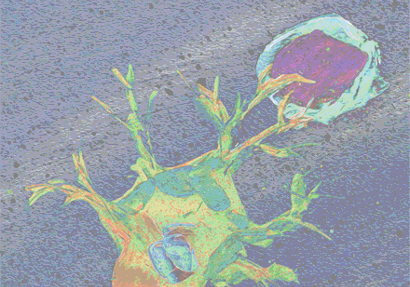Elucidation of kidney protection mechanism through nervous and immune systems
We have so far showed the following: 1) Vagus nerve stimulation (VNS) protected the kidney from acute kidney injury. 2) α7 nicotinic acetylcholine receptor (α7nAChR) positive macrophages and β2 adrenergic receptor positive CD4 T cells play an important role in exerting the renal protection effect by VNS (Inoue*, Abe* et al. *Equally contributed. . J Clin Invest. 2016). 3) We newly identified Hes1 (hairy and enhancer of split-1) as downstream gene of α7nAChR by RNA-seq and functional analysis of genes (Inoue et al. Kidney Int. 2019). 4) It was discovered that C1 neuron stimulation in the medulla by optogenetics had a renoprotective effect (Abe*, Inoue* et al. *Equally contributed. Nat Neurosci. 2017). Thus, we are conducting world-leading research in this research field.



Immunostaining in kideny tissue
By utilizing the most advanced technologies such as comprehensive analysis of gene expression at single cell level (single cell RNA-seq), we are elucidating the functions of cell groups that are not yet clear in the kidney.


The adhesion of monocytes to the vascular endothelium plays an important role in the development of artherosclerosis. We aim to elucidate a novel mechanism involved in the development of atherosclerosis, which is regulated by nerve stimulation.


Therapeutic effect of vagus nerve stimulation
In cisplatin-induced acute kidney injury model, we found that vagus nerve stimulation can reduce the damage even after the kidney injury is induced, and that factors such as CCL2 involved in macrophage migration are important for its effect. (Sci Rep 2020).


The interaction between nervous and immune systems
The relationship between the nervous system and the immune system is a new area of interest, such as being featured in a joint article on nature neuroscience and nature immunology (2017). Focusing on the relationship between different organs, especially on the nervous system and the immune system, we aim to elucidate a new organ protection mechanism.

